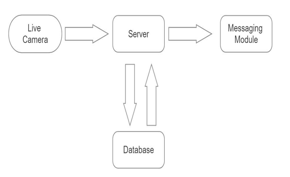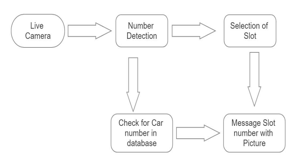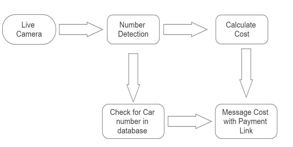Ijraset Journal For Research in Applied Science and Engineering Technology
- Home / Ijraset
- On This Page
- Abstract
- Introduction
- Conclusion
- References
- Copyright
Automated Parking System Using Number Plate Recognition
Authors: Anirudh S, Rohan Prasad N, S Prarthana, S M Tejas, Megha V
DOI Link: https://doi.org/10.22214/ijraset.2022.45153
Certificate: View Certificate
Abstract
Finding a suitable parking space as been a significant concern for people, The difficulty roots from not knowing where the parking spaces are available at the given time. The traditional parking methods cannot be used today as they are ineffective at utilizing space and are time consuming. As a result, the purpose of this research is to Automate the parking system using number plate recognition. The system uses image processing of recognizing registration plates of the vehicles for operation of parking system. Overall, the systems run with pre- programmed controller to make minimize the human interaction in parking system
Introduction
I. INTRODUCTION
When we take into consideration the current world scenario, we see that Covid has taken over our typical lives. One of the vital elements involved in the service being offered to customers around the globe is human touch. An operation carried out by a robot is considered of lesser quality when compared to that action which involves the need of humans. But we certainly cannot assume this right in our current situation. The Covid-19 might seem to be ended but the threat is never nil.
Adding onto the above scenario, we often end up in some situations when we have struggled hard just to find a parking spot which is unoccupied in a certain parking area. It might get complex for someone new and cost them their precious time which is not ideal and needs to be dealt with. Hence to solve these problems we’ve come up with an astounding idea to develop an automated parking system which is free of human touch and aids the customer to find a nearest parking spot in the available list of options. Adding on to this we also have added a feature to make this process hassle free by making the payment for the utilized period of time online through our mobile application.
II. RELATED WORK
It’s ongoing research to find the most optimal and time efficient way for parking mechanisms in the malls. Many researchers have proposed various methodologies to solve this problem.
In the reference paper[7] used the Faster R-CNN method to detect the number plate using a surveillance camera. Whereas faster R-CNN used a separate network to predict the region that was proposed. The image then underwent character segmentation, image interpolation and Optical Character Recognition(OCR). This method was 99.1% accurate.
In the reference paper[1] proposed the method of recognizing the vehicle’s license plate number manually at the parking lot . The methodology they used was conversion of RGB image to Grayscale image and then converting the grayscale image to binary image. Further they applied noise reduction, character segmentation and OCR.
In the reference paper[2]proposed the automation of car parking systems using an android application. The methodology involves four modules for implementation of this system those are Interfacing of Microcontroller with LCD, GSM and RF module.And an Android Application.
In the reference paper[3] implemented a number plate identification system using image processing concepts.
This system imposed Binary image processing, Contrast extraction, median filtering. Character Segmentation extracted the character from the number plate. The resulting image was taken as input and then compared with the database using the method of OCR.
The reference paper[4] used the method of UAV vision which detected the number plate using a camera at the entrance as well as the exit. Methodology implemented was Tesseract OCR Engine which is a type of OCR also called as Google OCR that is used for character Recognition. And to improve the OCR they used a look-up table. This method was 70% accurate, Cost and maintenance of drones and the low-quality image from the drones were a major drawback.
In the reference paper[5] proposed an intelligent parking system especially for cities.They used IOT and cloud functions to improvise the parking system in the cities.
Methodology on which the parking system is designed was subjected to four stages: device and networking level, Internet of things platform level and parking application level.
- Ultrasonic Detector for vehicle detections
- Path optimization with ant colony algorithm
In reference paper[6] proposed a method to solve the problem of inefficient and disordered parking with respect to buildings. It was based on methodologies such as License plate detection , Character segmentation, Character recognition, OCR. With time the usage of methodology differed with the result of the accuracy they propose.
For the development of autonomous or intelligent parking systems, a variety of strategies are used. The study of these systems reveals that their proper operation necessitates some or all human interaction. Image processing has been considered as one of the intelligent systems for car parking. A brown circular image of the parking slot is collected and processed in this method to detect a free parking slot. The 7-segment display shows information about the currently available parking spaces. Initially, a brown-rounded image of parking spaces is captured. To make binary pictures, the image is segmented. The image's noise is eliminated, and the object boundaries are traced.
A vision-based automobile parking system is being developed that detects free parking spaces using two types of pictures (positive and negative). The object classifier recognises the needed item inside the input in this function. Pictures of vehicles from various viewpoints may be found in positive images. There are no automobiles in negative photos.
To identify the presence of automobiles in the area, the given co- ordinates of parking lots are utilised as input. For feature detection, car-like characteristics are employed. However, depending on the type of camera utilised, this technique may have limits. Furthermore, because the coordinate system picks precise parking spaces, the camera must be fixed. The method may be limited by a limited collection of positive and negative pictures.
The number plate recognition approach, which is being used to construct an automated automobile parking system, is based on image processing. The picture of the vehicle's licence number plate is captured in this method. It's then divided to get the number plate's component characters.
Free parking spaces are detected using ultrasonic sensors. The number plate photos are then captured and analysed. At the same time, the current time is recorded in order to compute parking rates. The LCD shows a 'FULL' indicator, indicating that no parking space is available. However, the method has several constraints, such as the backdrop colour being required to be black and the character colour being white. In addition, the study is limited to one-row number plates. A mechanical model with image processing capability was presented as part of the Smart Parking system concept. The automobile would be parked on numerous floors using lifts. In order to prevent unauthorised automobile entrance, image processing is also employed to record the number plate and store it in a database for comparison.
As a result, we want to offer an automobile parking system that is totally automated with minimal human interaction, and that overcomes the limits of current systems.
III. MOTIVATION
With rising urbanisation and increased population density in cities, mobility solutions are in greater demand. Many individuals in industrialised economies choose private autos as a form of mobility. As the level of living rises in many regions of the world, an increasing number of people and businesses purchase new automobiles.
The difficulty of finding place to park these automobiles in cities has arisen as a result of this. The parking lot concept has grown significantly over time, from just a space where individuals may park their automobiles to areas where automated solutions are used to assure security and operating efficiency.
Malls and other commercial hubs are sprouting up all over cities, drawing a rising number of individuals who prefer to drive in. This has boosted the need for mall parking lot management systems, not only to ensure that customers have a pleasant experience, but also to avoid squandering money and resources.
Information management is also problematic with paper-based ticketing systems. The administration should be able to offer information about any car parked in their spot instantly in the event of any unpleasant situations. This is made feasible by automated electronic systems.
IV. PROBLEM FORMULATION

A camera near the society gates that can record images of automobiles together with their licence plates and send them to the server runs an algorithm to extract only the licence plates from the obtained picture. The number plates are retrieved using the clever Edge detectors, which will only identify the automobile number plates in the image and delete all other unneeded elements.
V. PROBLEM SOLVING
A. Module 1
Canny Edge Detector:
Initially, the picture is converted to a B/W format since it's easier for the Canny Edge detector to work in that particular format, after which the image is resized to fit the right size suitable for detection. A bilateral filter is applied in the later stages, to reduce the noise obtained from the original image. Then finally the actual edge detector is applied to crop out the other things from the image retaining only the number plate. Optical character Recognition: Tesseract OCR An Optical Character Recognition Engine (OCR Engine) to automatically recognize text in vehicle registration plates.
Py-tesseract is an optical character recognition (OCR) tool for python. That is, it’ll recognize and “read” the text embedded in images. Python- tesseract is a wrapper for Google’s Tesseract-OCR Engine. It is also used as an individual script, because it can read all image types like jpeg, png, gif, bmp, tiff, etc. Additionally, if used as a script, Python-tesseract will print the recognized text rather than writing it to a file. It has ability to recognize more than 100 languages.
OpenCV is an open source computer vision library. The library has more than 2500 optimized algorithms. These algorithms are often used to search and recognize faces, identify objects, recognize scenery and generate markers to overlay images using augmented reality, etc.
B. Module 2

Once the numbers from the number plate are obtained, that number is checked from the database to obtain the owner's info, once we get that information a basic linear algorithm is run to assign the nearest slot for the car, and the slot details along the map route is sent to the owner's message, which can be followed along to reach the allotted slot.
C. Module 3

This is the reverse of the second and first module, an exiting camera which tracks the outgoing vehicles and clicks pictures to detect the car numbers of outgoing cars, and then the module 1 algorithm is applied in the same way to extract car numbers. Once it's done, the database is checked for entry time and using the current time as exit time, the cost is calculated about which another message is sent to the user when they exit. Which includes the cost along with the payment link, using which the user can directly pay via UPI.
VI. DATA MODEL
A. User Table
|
Attribute |
Data Type |
Description |
|
UserID |
INT |
Unique key given to the user |
|
Ph No |
INT |
User’s phone number used to send the message |
|
Car No |
STRING |
Number detected by the algorithm using the number plate |
|
Name |
STRING |
Name of the user |
B. Parking Table
|
Attribute |
Data Type |
Description |
|
Parking ID |
INT |
|
|
UserID |
INT |
Unique key given to the user |
|
Entry time |
DATE TIME |
Entry time of the user into |
|
|
|
parking area |
|
Slot ID |
INT |
Slot number assigned |
|
Exit time |
DATE TIME |
Exit time out of the parking area |
|
Fee |
INT |
Total amount payable |
C. Slot Table
|
Attribute |
Data Type |
Description |
|
Slot |
INT |
Slot number assigned |
|
IsFilled |
BOOLEAN |
Checks whether the slot is filled or not |
|
Distance |
INT |
Distance from the entry |
Conclusion
While developing a life-size model, the model was analysed. The model has been created, and the programme has been successfully implemented. It depicts how the planned automated smart parking system operates. Space optimization, cost effectiveness, and execution are the primary advantages. of incommunicado.
References
[1] Worawut Yimyam and Mahasak Ketcham.”The Automated Parking Fee Calculation Using License Plate Recognition System”: converting RGB Image to Grayscale Image, Grayscale Image to Binary Image.2017; 978-1-5090-5210-3/17. [2] D.J. Bonde,Ketan Suresh Gaikwad,Rohit Sunil Shende,Akshay SambhajiKedari and Amol Uday Bhokre”Automated car parking system commanded By Android application”: Interfacing of microcontroller by LCD,GSM,RF Model and Android Application.2014;978- 1-4799-2352-6/14. [3] Abhishek Kashyap, B. Suresh, Anukul Patil, Saksham Sharma and Ankit Jaiswal. “Automatic Number Plate Recognition”: This system uses binary Image processing,Contrast extension and median filtering.2018;978-1-5386-4119-4/18. [4] Jun Ryeol Park, Nasir Rahim, Seung Ju Lee, Amin Ullah, Mi Young Lee and Sung Wook Baik.”License Plate Recognition for Parking Management System using UAV Vision”:Tesseract OCR Engine for character recognition And Look-up table to improve OCR.2018;Vol.150 (AST 2018), pp.66-70. [5] Ming Wang, Huifang Dong, Xu Li, Liangliang Song, Dandan Pang. “A Novel Parking System Designed for Smart Cities”:Ultrasonic Detector for vehicle detections and Path optimization with ant colony algorithms.2017;978-1-5386-3524-7/17. [6] Abdul Quadir,C.R Dhruv, Arun Kumar Sivraman, Rajiv Vincent.”Automatic Number Plate Recognition System for Parking”:Licenseplate detection , Character segmentation , Character recognition, OCR. [7] N.Palamivel Ap, T Vigneshwaran, M.Srivarappradhan and R.Madanraj. “Automatic Number Plate Detection in Vehicles using Faster R-CNN”: Used the Faster R-CNN method to detect the number plate using a surveillance camera.2020;978-1-7281-6202- 7.
Copyright
Copyright © 2022 Anirudh S, Rohan Prasad N, S Prarthana, S M Tejas, Megha V. This is an open access article distributed under the Creative Commons Attribution License, which permits unrestricted use, distribution, and reproduction in any medium, provided the original work is properly cited.

Download Paper
Paper Id : IJRASET45153
Publish Date : 2022-06-30
ISSN : 2321-9653
Publisher Name : IJRASET
DOI Link : Click Here
 Submit Paper Online
Submit Paper Online

